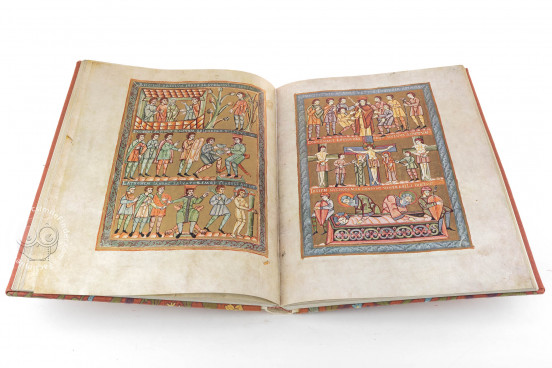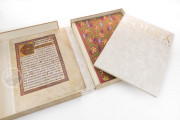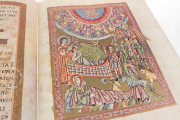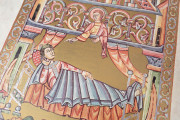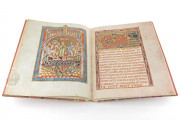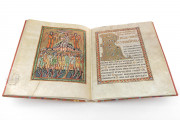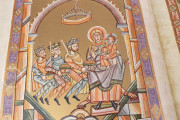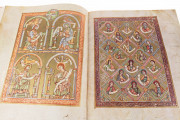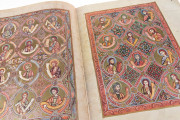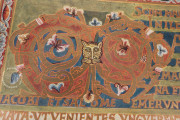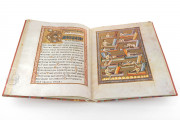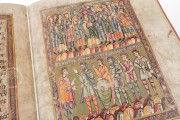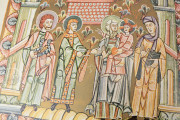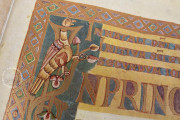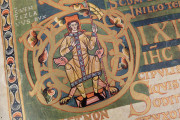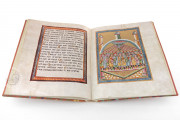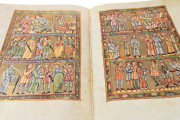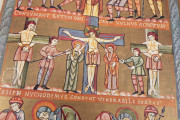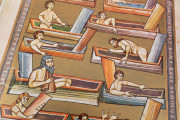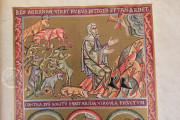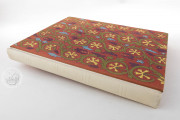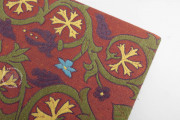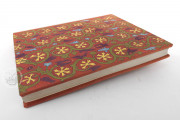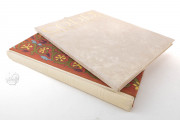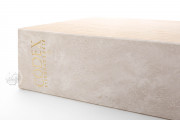The Codex of Vyšehrad is a magnificent example of a Romanesque manuscript. Made around 1085 and around the time of the coronation of the first king of Czechoslovakia, Vratislav II (1061–1092), it includes the lection (prayers) for the coronation of a king. It is believed to have been made in Bohemia, but the miniatures are of such excellence that some historians consider it might have been made elsewhere. It is more likely that experienced artists traveled to Bohemia and undertook the work there.
The manuscript is one of a group of four manuscripts thought to have been made by the same artists between 1080 and 1085. These other manuscripts are in the Library of St Vitus Chapter, Prague Castle, the Chapter Library in Gniezno, Poland, and the Czartoryski Library in Cracow. Vratislav had good relations with Poland and the manuscripts may have been generous gifts to commemorate his coronation. The Codex of Vyšehrad is the largest and finest example of the group.
Fit for a King
The extensive cycle of images, carefully rendered and detailed, mark this manuscript as distinctive. The depictions are the work of several artists, but one artist known as the Master of the Codex Vyšehradensis may have overseen the project thus maintaining the standard throughout. The style itself owes much to the Regensburg school and Ottonian influences.
Of particular note is the manner in which Christ’s genealogy is depicted on four meticulously divided pages. Fol. 2r is divided into eighteen diamond shapes, fol. 2v twelve circles, and fols. 3r, 3v a combination of the two. A depiction of one of Christ’s forebears, each holding a scroll, is in each shape. The result of such careful planning are four harmonious and highly detailed decorated pages.
Also of note is possibly the earliest depiction of the Tree of Jesse (fol. 4v). This depiction illustrates the passage from Isaiah 11:1-3, “And there shall come forth a rod out of the root of Jesse, and a flower shall rise up out of his root.” In the Codex, Jesse is depicted upright with a tree emerging from his foot. Later depictions invariably show the tree emerging from Jesse’s groin, as in the Lambeth Palace Bible, England, 1150–1170, Lambeth Palace Library, MS 3.
In the 108 folios, there are twenty-six pages depicting the gospels, four pages of Christ’s genealogy, four of the Old Testament, and twenty-nine scenes from the life of Christ. There are also a number of large, decorated initials with vegetative designs.
The depictions are drawn with a strong outline, characteristic of the Romanesque style, and infilled in tones of red from rose-pink to red, olive-greens, light-blues, violet and ochre against a golden background and encased with similarly colored decorated borders.
Majesty in Majuscule
Unusual for the period, the text is rendered in a mix of two majuscule scripts: Roman capitals and Uncials. During the period these scripts were generally used for display or headlines, not text. Roman capitals are based on the monumental square capitals derived from Roman inscriptions and noted in manuscripts of Late Antiquity, for example the sixth-century manuscript Vaticanus Augusteus, Vatican, Bibliotheca Apostolica, Ms Vat. lat. 3256. The other majuscule script employed is Uncial, in use from the seventh century.
Characteristic features of majuscule scripts include no word spacing and the use of only one script with varying sizes and colors to indicate a hierarchy of text. However, in the Codex word spaces have been inserted along with script notation for abbreviations. Throughout, the first letter of each sentence is generally larger and painted in gold with red outline.
Depicted on fol. 68r is the enthroned figure of St. Wenceslas, a Czech prince and martyr (d. 935). In white chalk near the figure in written: S. VENZELAVVS DUX. The depiction accompanies the lections for the birthday of the saint. To emphasize the importance of the saint the entire text is written in gold majuscule outlined in red.
The Price of a Kingdom
The Codex was originally the property of the Church of Vyšehrad, although some scholars believe the manuscript was originally prepared for St Vitus Cathedral in Prague Castle, coronation church of the Czech kings. Vratislav II was the first king of Bohemia and attained this title through negotiations with the then Holy Roman Emperor, Henry IV.
Henry IV was at odds with the Roman church. He insisted on retaining the Slavonic liturgy, refusing to adopt the Roman rites which Pope Gregory VII insisted be employed. Henry also contested the removal of his right to appoint bishops. This led to the investiture crisis, not resolved until the Concordat of Worms in 1122.
Henry enlisted the help of Vratislav in his conflict with Rome since Bohemia at the time was an important power. Vratislav agreed to assist but in exchange demanded the rights of a kingdom and a hereditary title. This was a significant request.
With the dual authority of Rome and the Holy Roman Empire it became impossible for regions under their dominion to achieve independent status, which is what a kingdom signified. Nonetheless, Henry assented: but after Vratislav died the title was denied to his heirs.
In 1728 the Codex of Vyšehrad was acquired by the library of the Prague Archbishopric Seminary. It is now housed at the State Library of the ČSR – the University Library in Prague.
The current cover consists of wooden boards covered in leather. Fragments of the original linen covering on the back-cover are overlaid by fragments of richly decorated embroidered material. On the center of the back cover are the fragile remains of a large twelfth-century embroidery depicting Christ in a mandorla.
We have 2 facsimiles of the manuscript "Codex of Vyšehrad":
- Codex Vyssegradensis facsimile edition published by Tempus Libri, 2014
- Codex Vysehradensis facsimile edition published by Sumptibus Pragopress, 1970


